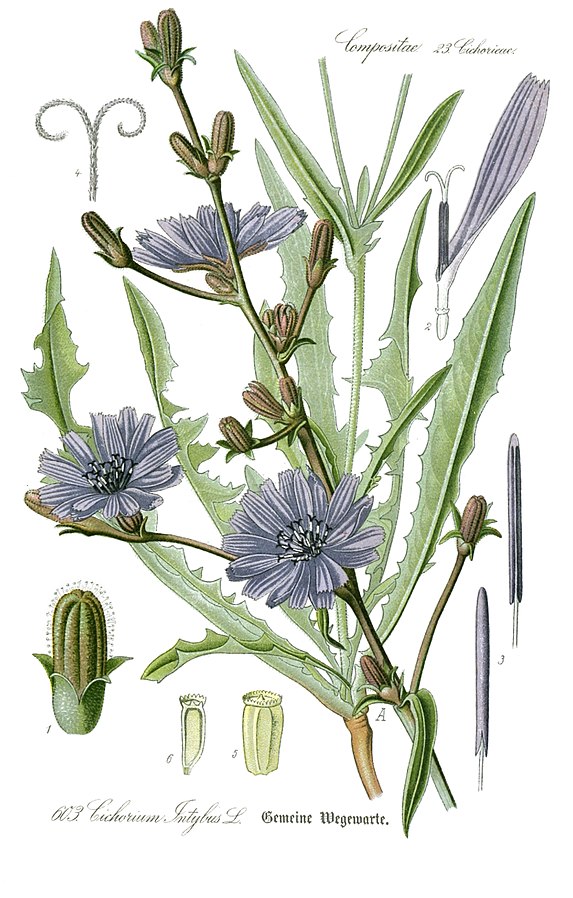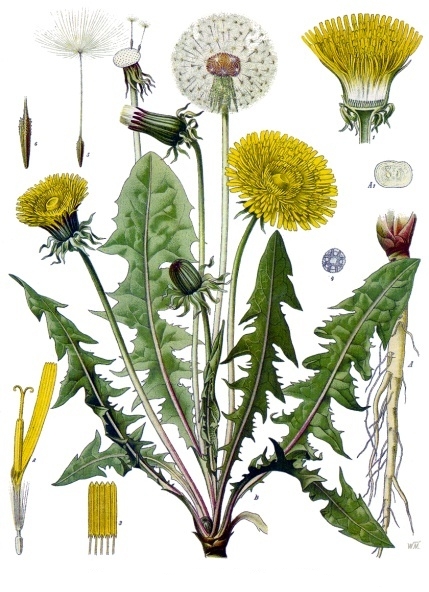Coffee Substitute – Why Use Plant Roots: Chicory and Dandelion
It’s almost winter, but you can still take your basket and go for chicory and dandelion root harvesting. By combining the two, you can enjoy various benefits, including an alternative to coffee. If you add cereals such as barley, oats, rye, wheat, or even oak acorns to this coffee substitute, you can create mixtures with diverse and healthy flavors.

Chicory
The root of chicory (Cichorium intybus) comes from the plant of the same name, a flowering plant with bright blue flowers that belongs to the daisy family and grows throughout Romania.
It has been used since ancient Egypt, both in cooking and traditional medicine. Due to its taste and color similar to coffee, it is often prepared as an alternative to coffee.
During World War II, when transportation from coffee-producing countries was interrupted, the use of chicory to produce “coffee” became very popular.
Chicory root has also been added to the production of certain beers and more recently incorporated into cocktails to add an earthy, bitter tone. Furthermore, specialized literature emphasizes that the fibers in chicory root have numerous health benefits and are often extracted for use as a food additive or dietary supplement.
Benefits of Chicory Root
1. Provides Prebiotic Fibers
Fresh chicory root is composed of 68% inulin by dry weight, according to healthline.com. Inulin is a type of fiber known as fructan or fructo-oligosaccharide, a carbohydrate made up of a short chain of fructose molecules that your body does not digest. It acts as a prebiotic, meaning it feeds beneficial bacteria in the intestines. These bacteria play a crucial role in reducing inflammation, combating harmful bacteria, and improving mineral absorption. Thus, the fiber from chicory root can contribute to optimal gut health.
2. Aids in Intestinal Regularity
Because the inulin in chicory root fiber passes through the body undigested and nourishes intestinal bacteria, it can support healthy digestion. In particular, specialized studies suggest that inulin may alleviate constipation. A study mentioned by healthline.com, conducted over 4 weeks with 44 adults experiencing constipation, found that the administration of 12 grams of chicory inulin per day helped soften stools and significantly increased the frequency of bowel movements compared to administering a placebo treatment.
4. Improves Blood Sugar Control
The fiber in chicory root can also contribute to blood sugar control, especially in individuals with diabetes. This is attributed to its inulin content, which promotes the growth of beneficial bacteria involved in carbohydrate metabolism—breaking down carbohydrates into sugars—and insulin sensitivity, the hormone that helps absorb sugar from the blood.
Chicory root fiber also contains compounds such as chicoric and chlorogenic acids, which have been shown to increase muscle sensitivity to insulin in rodent studies, as cited by healthline.com. Additionally, a 2-month study on 49 women with type 2 diabetes found that the daily administration of 10 grams of inulin led to significant reductions in blood sugar levels and hemoglobin A1c compared to a placebo treatment, according to the same source.
4. Supports weight loss
Some studies indicate that chicory root fiber can regulate appetite and reduce total calorie intake, which may lead to weight loss. A 12-week study involving 48 overweight adults, mentioned by healthline.com, concluded that daily intake of 21 grams of oligofructose derived from chicory (which is very similar to inulin) led to an average reduction in body weight of 1 kg, while the placebo group gained weight. The same study also found that oligofructose helped decrease the level of ghrelin, a hormone that stimulates hunger.
5. Easy to Add to Your Diet
It shouldn’t be very difficult to incorporate chicory root into your diet. In fact, you might already be consuming it without even being aware, as it is used as an additive in the food industry. Often, chicory root is processed to obtain inulin, which is used to increase fiber content or to serve as a sugar or fat substitute due to its gelling properties and sweet flavor. Moreover, inulin from chicory root is extracted and transformed into supplements, which are readily available in health food stores.
Warning: Chicory can trigger reactions in individuals allergic to ragweed pollen or sensitive to related plants, including chrysanthemums, marigolds, daisies, and other members of the Asteraceae plant family. Since chicory can stimulate bile production, its consumption could theoretically pose a concern for individuals with gallstones, but these are unlikely scenarios, according to Dr. Andrew Weil, on his blog drweil.com.
How to use chicory root at home
You can boil the entire chicory root and eat it as a vegetable. If you want to reduce caffeine, you can use roasted and ground chicory root as a coffee substitute. To prepare this beverage, add 2 tablespoons (approximately 11 grams) of ground chicory root for each cup (240 ml) of water.

Dandelion
How widespread it is across all meadows, you might think that dandelion (Taraxacum officinale) is a weed, isn’t it?
Well, you have no reason to disdain it because absolutely all parts of this wonderful plant, with its sun-like yellow flower, are good for human consumption. Dandelion is part of a large family of flowering plants called Asteraceae. It is a perennial plant native to Eurasia; today, various species of it can be found on all continents.
Dandelion has a long history of traditional medicinal uses in Arab, European, Chinese, and American traditions. The root is most often used for digestive issues, while the leaves can be used as a diuretic, and the leaves and flowers added raw to salads.
Benefits of Dandelion
1. Treats Liver, Kidney, and Spleen Issues
Traditionally, dandelion is used to treat issues related to the liver, kidneys, and spleen, acting as a diuretic. Modern herbal products such as teas, capsules, powders, chewable tablets, or extracts from fresh or dried roots continue to utilize dandelion for similar purposes. It can be used to stimulate appetite, improve digestion, alleviate gas and bloating, and act as a mild laxative. A pilot study cited by drweil.com found that dandelion leaves are indeed an effective diuretic.
2. Source of Vitamins
Dandelion is an excellent source of nutrients, surpassing the usual vegetables we regularly consume. It contains exceptional amounts of vitamin A and is a good source of vitamin C and B6, thiamine, riboflavin (also known as vitamin B2), and folic acid. You can increase your intake of these vitamins by consuming the green parts of dandelion raw, for example, in salads, soups, or even in stews (added at the end). If you harvest it yourself, make sure the area has not been treated with herbicides.
3. Acts as a Prebiotic
Similar to chicory, dandelion root is rich in inulin, a prebiotic that helps encourage the growth of healthy microorganisms in the gastrointestinal tract. While there are currently no clinical studies evaluating the effects of dandelion for various conditions, its diuretic effect has been demonstrated.
Warning: Dandelion may interact negatively with antibiotics, potentially reducing their effectiveness, as noted by Dr. Andrew Weil on his blog drweil.com. Additionally, according to the same source, individuals with ragweed allergies should exercise caution when using dandelion, as it may trigger an allergic reaction. Furthermore, individuals with an infected or inflamed gallbladder or blocked bile ducts should avoid the use of dandelion.
Tips for harvesting and using chicory and dandelion
The roots of chicory and dandelion can be harvested early in the spring, just before the plants enter their growing season (March at the latest, or April), or in the fall when the plants have exited their growing phase (late October to mid-November). The best roots are those of plants that are 2-3 years old, as their size is distinguishably larger compared to younger roots. After harvesting, they should be thoroughly cleaned with cold water and a brush, then finely chopped and placed on a tray with holes to facilitate faster drying. Drying should be done at a maximum temperature of 45 degrees Celsius for a period not exceeding 4 days.
If you don’t have the time or find it a bit challenging to harvest and prepare the roots of chicory and dandelion, we’d like to remind you that at Hodaia, in addition to producing natural body care products, we are also involved in education. We are happy to assist you with advice. Send us your questions at office@hodaia.ro. Soon, we will be starting a series of practical workshops that will include coffee substitute preparation sessions; workshops that we will announce on our Facebook and Instagram social media pages.
